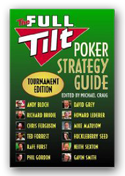 To his credit, David Gray’s Seven Card Stud chapter in the Full Tilt Poker Strategy Guide: Tournament Edition is actually about tournament strategy. Even when introducing basic concepts such as starting hand selection, which he is wise to do given that most of his audience will likely come from a NLHE background, he makes clear how his advice differs from standard cash game strategy. Having little background in tournament stud, it is hard for me to evaluate the quality of Gray’s advice. The strategy he suggests seems a sound one, but it concerns me that much of what he says sounds disturbingly like the overly weak tight approach to tournament NLHE that many sub-par players adopt.
To his credit, David Gray’s Seven Card Stud chapter in the Full Tilt Poker Strategy Guide: Tournament Edition is actually about tournament strategy. Even when introducing basic concepts such as starting hand selection, which he is wise to do given that most of his audience will likely come from a NLHE background, he makes clear how his advice differs from standard cash game strategy. Having little background in tournament stud, it is hard for me to evaluate the quality of Gray’s advice. The strategy he suggests seems a sound one, but it concerns me that much of what he says sounds disturbingly like the overly weak tight approach to tournament NLHE that many sub-par players adopt.
In the early rounds of a stud tournament, where stacks are deep relative to the stakes, Gray advises nothing more than a “good, normal, solid strategy” akin to what would be appropriate in a cash game. I appreciate that he doesn’t elaborate overly much on what exactly that is, since there are other, presumably better resources for learning the game of Seven Card Stud.
As its name implies, this compact chapter sets its sights on tournament stud, his approach to which Gray sums up as follows: “After the first few levels, you can’t afford to lose a full pot in a tournament and still have relative chip strength. You are definitely looking to play a top hand and move on people you think have nothing.” His point is that you can’t afford to play from behind. Even when getting the right pot odds, the price is too high to chase a likely big pair with a flush draw or an underpair and an overcard or two, since you end up crippled all too frequently.
But doesn’t one also lose money by folding when the odds are good? Gray does his best to mitigate this effect by advising extreme selectiveness on third street (you can’t make a four-flush if you fold your three-flush) and again on fifth street, when the bets double and calling is likely to price yourself in until seventh.
Intuitively, this cautiousness makes sense, and I’m inclined to say that it’s good advice. What concerns me is Gray’s occasional resort to weak-tight tournament platitudes such as, “a tournament… is about losing the least, especially because losing hurts you more than winning helps–when you’re out, you’re out.” I’ve just heard this from too many old nits at live tournaments to accept it as gospel in a stud tournament with no further analysis. I’d like to know that Gray is aware of this principle’s flawed application in NLHE tournaments and nonetheless believes it relevant in a stud setting.
It is also hard to say when exactly one ought to switch from cash game to tournament strategy. Gray advises that, “Until you are very close to the money, you should play your normal strategy.” However, his warrants for especially cautious play relate more to stack depth than to the divergence between chip equity and cash equity.
Presumably it is acceptable and maybe necessary to take some gambles when your stack gets small relative to the stakes. As he cautions, “If you play too tight, you can become so low on chips that even winning with your last chips doesn’t improve your position.” But in lieu of advice about how to navigate between these extremes, the reader gets only an acknowledgment of the challenge: “Weighing proper strategy… against your survival is difficult, and though I recommend you place a very high value on your survival, you sometimes have to risk going broke.”
This tight strategy works, Gray believes, because other players tend to be overly loose and because stud poker is not a game of implied odds. It is difficult to make a killing with a concealed monster the way one can in NLHE by flopping a set or an unlikely two pair. Thus, his goal is to stay out of trouble, play mostly big pairs and rolled up trips, and take advantage of others’ loose play. As Gray puts it, “I don’t ever want to enter a pot where I don’t think I’m a favorite.”
Gray addresses some other unique elements of tournament poker, such as the fact that the ratio of ante:big bet will change from level to level, necessitating an adaptation in hand selection that few players recognize. He also considers short and big stack play, arguing that the former need to pick a hand and stick to it, whereas the latter ought to splash around a bit more but get out of the way quickly when a shorter stack shows interest, since that player can probably not be bluffed out.
David Gray’s tournament stud strategy seems like a useful one, particularly for those new to the game, ie the majority of his readers. It is designed to keep you alive, keep you out of trouble, and put you in position to win some money. With a good table draw and a bit of luck, it might even win you a tournament or two.
